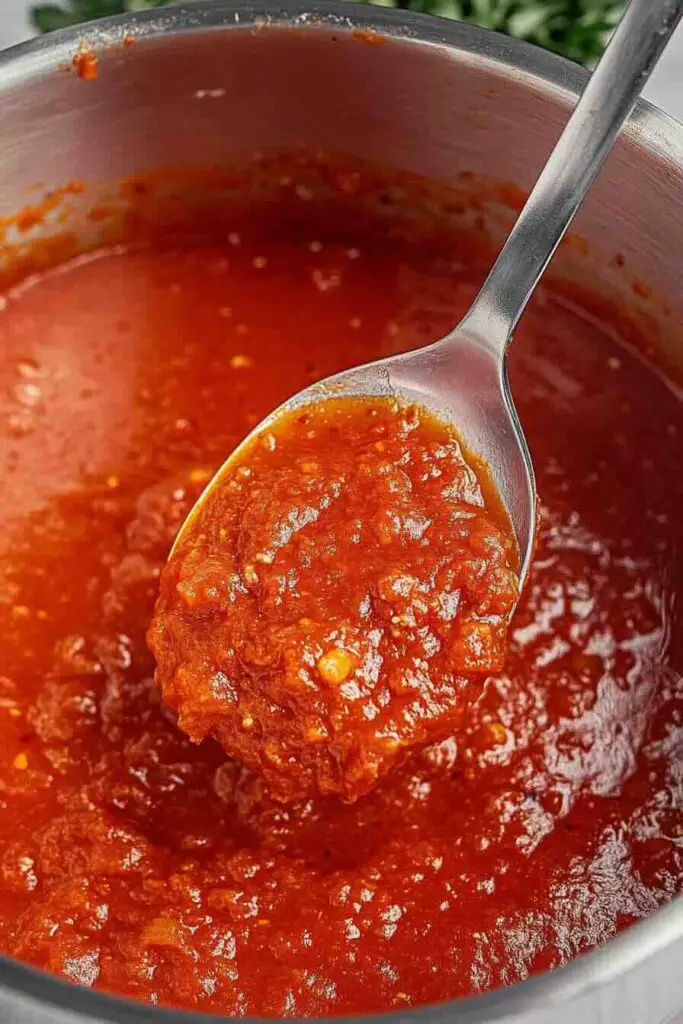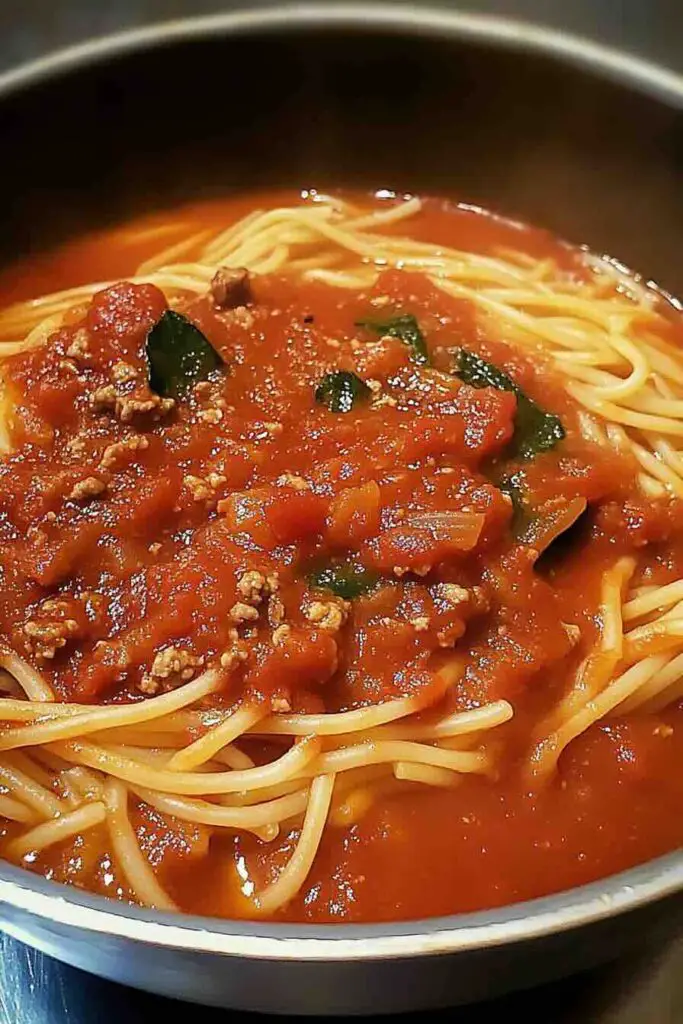Introduction
Spaghetti sauce. It’s one of those things that seem simple—just tomatoes and some seasoning, right? Oh, but no. A truly great homemade spaghetti sauce is rich, complex, and layered with deep, savory goodness. It clings to your pasta like it was meant to be there, balancing acidity, sweetness, and umami in every bite.
Sure, you could grab a jar from the store, but let’s be honest—most of them taste like vaguely seasoned tomato puree. When you make it from scratch, you control everything: the thickness, the depth, the spice level. And the best part? It’s easier than you think. With a handful of pantry staples and a little patience, you can whip up a sauce that’s miles ahead of anything mass-produced.
This isn’t just a recipe. It’s a method. A blueprint for spaghetti sauce greatness. And by the end, you’ll not only have a killer sauce, but you’ll also understand why each step matters. Ready? Let’s go!

Reasons You’ll Love This Recipe
There are a million spaghetti sauce recipes out there, so what makes this one stand out?
- Unbeatable flavor – A slow simmer unlocks deep, rich, well-rounded notes. No one-dimensional tomato taste here!
- Ridiculously easy – You don’t need fancy ingredients or a culinary degree. Just a little time.
- Customizable – Want it spicy? Creamy? Meat-heavy? You got it. This base sauce can be tweaked endlessly.
- Budget-friendly – Making it from scratch costs way less than buying premium store-bought sauces.
- Perfect for meal prep – Freezer-friendly and even better the next day. Make a big batch, and future-you will thank you.
What Makes a Good Spaghetti Sauce?
Key Flavor Elements
A good sauce is all about balance. Too acidic, and it’s harsh. Too sweet, and it tastes artificial. You need a little bit of everything to hit that chef’s kiss moment.
- Rich tomato base – Canned tomatoes are the backbone. San Marzano? Ideal. Regular crushed tomatoes? Still solid.
- Aromatic seasonings – Garlic, onions, and Italian herbs bring depth. Fresh is great, but dried works too.
- Savory umami boosters – Ground beef, Worcestershire sauce, and even a parmesan rind add that something extra.
- Balanced acidity & sweetness – A pinch of sugar helps mellow out the sharpness of the tomatoes.
Texture & Consistency
Some like it chunky, some like it smooth. Some want it thick enough to cling to noodles, others prefer a lighter, more delicate consistency. The beauty of homemade sauce? You make the rules.
- Chunky vs. smooth – A quick blitz with an immersion blender creates a silky texture, while leaving it unblended gives you more bite.
- Thick vs. thin – Letting it simmer longer thickens it up naturally. A splash of water or broth can loosen it up.
Cooking Time & Layering Flavors
- Simmering is key – The longer it cooks, the deeper the flavors get. Even 30 minutes makes a difference, but if you can go for an hour or more? Chef’s kiss.
- Timing for fresh herbs – Toss basil in at the end so it stays vibrant. Dried herbs, however, love a long simmer.
The Cultural Significance of Spaghetti Sauce
Spaghetti sauce isn’t just a meal—it’s a tradition. It’s the smell of home, the heart of Sunday dinners, and the reason grandmothers all over the world guard their “secret” recipes like treasure.
In Italy, pasta sauce varies wildly by region. Southern Italy leans on bright, tomato-heavy sauces, while Northern Italy favors creamier, meatier varieties. When Italian immigrants arrived in America, they adapted, adding more garlic, oregano, and meat, creating the rich, bold “Sunday Sauce” many of us know and love.
Today, spaghetti sauce is a universal comfort food, enjoyed in kitchens across the globe. But no matter where you’re from, one thing remains true: homemade always wins.
History of Spaghetti Sauce
Origins in Italy
Tomatoes weren’t even native to Italy. They arrived from the Americas in the 16th century, and at first, people were suspicious. But once they figured out how incredible tomatoes could be when cooked down with olive oil, garlic, and herbs? Game over.
Introduction to America
Italian immigrants brought their sauce-making traditions with them in the late 19th and early 20th centuries. However, since fresh tomatoes weren’t always available year-round, canned tomatoes became the go-to. Enter: the rich, slow-simmered, meaty “Sunday Gravy” that became an Italian-American staple.
Modern-Day Popularity
From fancy restaurant versions to the jarred sauces lining grocery shelves, spaghetti sauce has become a global phenomenon. But even with endless options, nothing quite compares to a homemade pot bubbling away on the stove.
Ingredients Breakdown
Essential Components
- Ground beef – Gives the sauce a hearty, meaty bite.
- Tomato sauce & tomato paste – Forms the flavor-packed base.
- Italian seasoning & garlic powder – Adds depth and aroma.
- Worcestershire sauce – The secret weapon for umami goodness.
- Granulated sugar – Just a touch to balance acidity.
- Fresh basil (optional) – Brightens everything up at the end.
Customizations & Substitutions
- Meat options – Ground turkey, sausage, or even plant-based crumbles.
- Dairy additions – Parmesan or a splash of cream for extra richness.
- Extra veggies – Mushrooms, bell peppers, or shredded carrots sneak in extra nutrients.
Equipment You’ll Need
- Large skillet or saucepan – For simmering everything together.
- Wooden spoon or spatula – Essential for stirring and breaking up meat.
- Knife & cutting board – For prepping ingredients.
- Measuring spoons & cups – Precision matters!
Step-by-Step Instructions
1. Brown the Meat
- Cook ground beef with onions until nicely browned.
- Drain excess grease—nobody wants an oily sauce.
2. Build the Sauce Base

- Stir in tomato paste, tomato sauce, Worcestershire sauce, and seasonings.
- Let everything meld together for a few minutes.
3. Add Liquid & Simmer
- Pour in a bit of water, mix, then let it gently bubble away.
- Simmer for at least 30 minutes, but longer is always better.
4. Final Touches & Serving
- Stir in fresh basil (if using) just before serving.
- Ladle over hot pasta, top with cheese, and dig in.
How to Tell When Spaghetti Sauce is Done
- Thickened texture – It should coat a spoon but still be pourable.
- Deep, rich flavor – No raw tomato taste—just pure deliciousness.
- Tender meat – Fully cooked and infused with saucy goodness.
Variations & Toppings
One of the best things about homemade spaghetti sauce is that it’s incredibly versatile. Whether you like it spicy, creamy, meat-heavy, or completely plant-based, there’s a variation that’ll suit your taste. And don’t even get me started on toppings—because let’s be honest, a great sauce deserves equally great finishing touches. Let’s dive into some fun ways to mix things up!
Variations: Make It Your Own
If you love a little heat in your Homemade Spaghetti Sauce, try making an Arrabbiata-style sauce by adding extra crushed red pepper flakes. The spice level is entirely up to you—start with a pinch and build from there. If you’re feeling extra bold, a finely diced chili pepper can take it to the next level.
For those who love a rich, creamy tomato sauce, stir in a bit of heavy cream, mascarpone, or even cream cheese toward the end of cooking. This addition creates a silky, velvety texture that clings beautifully to pasta. It’s like a cross between classic spaghetti sauce and a decadent vodka sauce—pure magic!
Meat lovers, listen up! You can easily turn this into a hearty meat sauce by combining ground beef with Italian sausage. The sausage adds extra fat, spice, and depth, making the sauce even more satisfying. If you want something even more robust, try using a mix of ground pork, veal, and beef for a traditional Italian Bolognese-style sauce.
And don’t worry, plant-based eaters—I got you! A vegetarian version of this sauce is just as incredible. Swap out the meat for finely chopped mushrooms, lentils, or even textured vegetable protein (TVP). These ingredients soak up the flavors of the sauce and provide that meaty texture without any actual meat.
Toppings & Pairings: Take It Over the Top
A good Homemade Spaghetti Sauce can stand on its own, but the right toppings can elevate it even further. The classic choice? Freshly grated Parmesan or Pecorino Romano cheese. The salty, nutty bite of the cheese enhances every single forkful of pasta.
For a fresh touch, sprinkle some chopped basil or parsley right before serving. The bright, herby contrast keeps the sauce from feeling too heavy. If you love a bit of heat, a dash of crushed red pepper flakes adds the perfect kick.
Want to go full-on Italian restaurant mode? Drizzle a bit of high-quality extra virgin olive oil over your plate just before digging in. It adds richness and rounds out the flavors beautifully. And let’s not forget garlic bread—because really, what’s a plate of spaghetti without a warm, buttery, garlicky sidekick?
Nutritional Insights
Homemade spaghetti sauce isn’t just delicious—it can also be surprisingly nutritious. Unlike many store-bought sauces, which are often loaded with excess sugar, preservatives, and sodium, making your own means you control exactly what goes in. Let’s break down what makes this sauce a solid addition to your meal plan.
Calories & Macronutrients: What’s in a Serving?
A typical serving of spaghetti sauce contains a balance of protein, healthy fats, and carbohydrates. The exact calorie count depends on the ingredients you use, but if you’re making a traditional meat-based sauce, you’re looking at roughly 200–250 calories per serving. The protein from the ground beef or turkey makes the sauce filling, while the tomatoes provide natural fiber and vitamins.
Lower Carb & Keto-Friendly Options
If you’re following a low-carb or keto lifestyle, this sauce can easily be adjusted to fit your needs. First, skip the sugar altogether or swap it for a keto-friendly sweetener like erythritol or monk fruit. Second, serve the sauce over zucchini noodles, spaghetti squash, or shirataki noodles instead of traditional pasta. You’ll get all the flavor with a fraction of the carbs!
Reducing Sodium & Sugar: A Healthier Alternative
Many jarred sauces contain an alarming amount of sodium and hidden sugars. When you make your own, you can cut down on both. Instead of adding granulated sugar, try balancing acidity with grated carrots or a splash of balsamic vinegar—both add natural sweetness without refined sugar. To reduce sodium, simply use low-sodium canned tomatoes and adjust the seasoning to taste.
Pro Tips & Tricks
Want to make the absolute best spaghetti sauce of your life? These tried-and-true tips will take your sauce from good to unforgettable.
Build Flavor from the Ground Up
One of the biggest mistakes people make is rushing the first steps. Take the time to sauté your onions and garlic properly before adding anything else. This step deepens the overall flavor of the sauce and ensures there’s no raw, overpowering bite to the aromatics.
Let It Simmer Low and Slow
If you’re tempted to crank up the heat and rush the cooking process, don’t! Low and slow is the way to go. The longer your sauce simmers, the more the flavors develop. Even an extra 30 minutes can make a world of difference. If you’ve got the time, let it go for an hour or more!
Add a Parmesan Rind for Umami Goodness
Got a leftover parmesan rind sitting in your fridge? Throw it into the sauce while it simmers! It melts down just enough to infuse the sauce with an incredible depth of flavor. Trust me, this little trick is a game-changer.
Use High-Quality Tomatoes
The secret to an outstanding sauce? Good tomatoes. If you can get your hands on San Marzano tomatoes, go for it. Their natural sweetness and lower acidity make them perfect for sauce. If not, choose a quality canned tomato brand—trust me, it makes all the difference.
My Take on The BEST Homemade Spaghetti Sauce
I’ve made a lot of spaghetti sauces in my life—some great, some… let’s just say not so great. Through trial and error, I’ve figured out what works, what doesn’t, and what absolutely has to be in the sauce for it to be next-level good.
Homemade Spaghetti Sauce? It’s my go-to. I love it because it’s easy, foolproof, and packed with deep, rich flavors. The slow simmer makes all the difference, and the balance of acidity, sweetness, and umami is just right.
Could I tweak it? Of course! Some days, I throw in extra herbs. Other times, I add cream for a luxurious twist. That’s the beauty of homemade—it’s all about making it your own.

Storage & Health Tips
How to Store Leftovers
Got extra sauce? Lucky you! This sauce actually tastes better the next day, so storing leftovers is a win-win.
- In the fridge – Store in an airtight container for up to 4 days.
- In the freezer – Portion into airtight containers or freezer bags and freeze for up to 3 months.
Best Ways to Reheat
- Stovetop – Reheat over low heat, adding a splash of water if needed.
- Microwave – Heat in 30-second bursts, stirring in between.
FAQs About Homemade Spaghetti Sauce
What’s the one ingredient that makes spaghetti sauce better?
Worcestershire sauce! It’s unexpected, but it adds a deep umami richness that makes a world of difference.
How do you fix a spaghetti sauce that’s too acidic?
Add a pinch of sugar, grated carrots, or a splash of heavy cream to balance out the acidity.
What gives spaghetti sauce the best flavor?
A combination of slow simmering, quality tomatoes, and well-balanced seasonings. Also, a parmesan rind never hurts!
Can I make spaghetti sauce without meat?
Absolutely! Mushrooms, lentils, or a mix of bell peppers and onions make fantastic meatless alternatives.
Before You Go…
Craving more goodness? Check out my recipe for Spaghetti Bolognese next. It’s just as comforting, indulgent, and easy to make. You’re going to love it! ❤️
Print
The BEST Homemade Spaghetti Sauce
- Prep Time: 10 minutes
- Cook Time: 45 minutes
- Total Time: 55 minutes
- Yield: 6 servings 1x
Description
This is the BEST homemade spaghetti sauce—rich, hearty, and bursting with flavor! Made with simple ingredients like tomatoes, garlic, and ground beef, this sauce simmers to perfection, creating a comforting, restaurant-quality dish. Whether you prefer a classic, meaty version or a plant-based alternative, this recipe is fully customizable and absolutely delicious. Serve it over your favorite pasta with a sprinkle of Parmesan for the ultimate Italian-inspired meal.
Ingredients
- 1 lb ground beef (or Italian sausage)
- 1 small onion, finely chopped
- 3 cloves garlic, minced
- 1 (28 oz) can crushed tomatoes (San Marzano recommended)
- 1 (15 oz) can tomato sauce
- 1 (6 oz) can tomato paste
- ½ cup water (or beef broth)
- 1 tbsp olive oil
- 1 ½ tsp Italian seasoning
- 1 tsp salt (adjust to taste)
- ½ tsp black pepper
- ½ tsp red pepper flakes (optional for heat)
- 1 tbsp Worcestershire sauce
- 1 tsp granulated sugar (or grated carrot for natural sweetness)
- ½ tsp dried oregano
- ½ tsp dried basil
- ¼ tsp paprika (optional for depth)
- 1 Parmesan rind (optional, but highly recommended)
- Fresh basil, chopped (for garnish)
- Grated Parmesan cheese (for serving)
Instructions
-
Sauté the Aromatics – In a large skillet or saucepan, heat olive oil over medium heat. Add chopped onion and cook until soft and translucent, about 3–4 minutes. Stir in the minced garlic and cook for another 30 seconds until fragrant.
-
Brown the Meat – Add ground beef (or Italian sausage) to the pan, breaking it up with a wooden spoon. Cook until browned and no longer pink, about 5–7 minutes. Drain any excess grease.
-
Build the Sauce – Stir in crushed tomatoes, tomato sauce, tomato paste, and water (or beef broth). Mix well to combine.
-
Season to Perfection – Add Italian seasoning, salt, pepper, red pepper flakes (if using), Worcestershire sauce, sugar, oregano, basil, and paprika. Stir well to blend the flavors. Drop in the Parmesan rind for an extra boost of umami.
-
Let It Simmer – Reduce the heat to low and let the sauce simmer uncovered for at least 30 minutes, stirring occasionally. For deeper flavor, simmer for up to an hour.
-
Final Touches & Serve – Remove the Parmesan rind (if used) and taste the sauce, adjusting seasonings as needed. Stir in fresh basil just before serving. Serve hot over cooked spaghetti with grated Parmesan cheese on top.
Notes
- Meat Options – Swap ground beef for ground turkey, pork, or a mix of Italian sausage for a more robust flavor.
- Vegetarian Alternative – Use finely chopped mushrooms or lentils instead of meat for a plant-based version.
- Make It Spicier – Increase the red pepper flakes or add a pinch of cayenne pepper.
- Creamy Twist – Stir in a splash of heavy cream or mascarpone for a luscious, creamy sauce.
- Freezer-Friendly – This sauce freezes beautifully! Store in an airtight container for up to 3 months.
Nutrition
- Calories: 275
- Sugar: 8g
- Sodium: 720mg
- Fat: 14g
- Carbohydrates: 22g
- Fiber: 4g
- Protein: 18g
